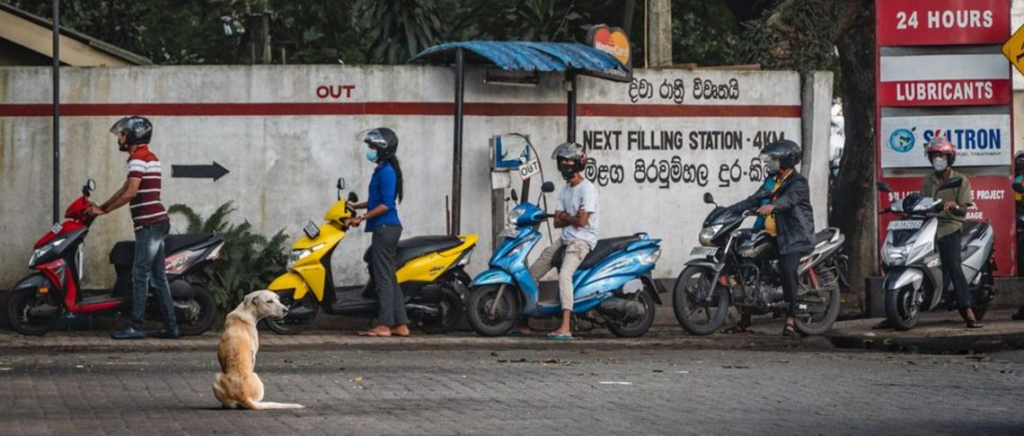More than a year after the mass protest movement known as the Aragalaya ousted Sri Lanka’s President Gotabaya Rajapaksa and his brother, Prime Minister Mahinda Rajapaksa, Sri Lankans have once again taken to the streets.
The impetus for the resurgence of public discontent is the recent bailout agreement between the International Monetary Fund and President Ranil Wickremesinghe’s government. The deal, which aims to address the country’s ongoing balance-of-payments crisis, offers Sri Lanka less than $3 billion over four years – a tiny fraction of what the country needs to meet its debt-servicing requirements and just one-sixth of its foreign-exchange earnings, which amounted to roughly $18 billion in 2022.
In exchange for this emergency loan, the IMF imposed a series of conditions that have significantly exacerbated Sri Lanka’s wage and cost-of-living crises. The mandated shift to market exchange rates, in particular, immediately led to a sharp currency devaluation, causing imported fuel and food prices to skyrocket and contributing to a 165% increase in electricity tariffs between June 2022 and February 2023.
As fiscal restraints were imposed, the economy continued to spiral down, with GDP shrinking by 7.8% in 2022 and 11.5% in the first quarter of 2023. This has had an adverse impact on employment, livelihoods, and the viability of small and medium-size enterprises. Consequently, real wages fell by 30-50% in 2022 and have remained stagnant.
Despite paying lip service to the importance of combating corruption and curbing illicit financial flows, the IMF plan falls short of tackling these issues effectively. Although it includes a modest increase in corporate income taxes, it neglects the possibility of imposing wealth taxes. Moreover, its focus on highly regressive measures, such as nearly doubling the value-added tax to 15%, means that the bulk of additional revenues will be generated through indirect taxes that disproportionately affect ordinary people.
The current wave of protests is partly a reaction to the government’s decision to comply with the IMF’s demand to restructure both external and domestic debt. Instead of focusing on lowering the external debt to a sustainable level, however, the agreement aims to bring down total debt, thereby reducing the haircut imposed on foreign creditors to just 30%. This has exacerbated the crisis and is difficult to justify. In countries that do not issue global reserve currencies, there is a clear distinction between domestic and external debt. Governments can and do service domestic debt using their own currencies, the supply of which is controlled by their central banks. By contrast, foreign currency-denominated debt necessitates either foreign-exchange earnings or new borrowing.
Sri Lanka’s crisis is largely the result of the country’s inability to service its external debt due to insufficient foreign-currency reserves. Since 2016, the government has preferred to take on new international loans, primarily from private lenders, to repay its foreign creditors, including bilateral and multilateral lenders. In early 2022, the government chose to default on its foreign loans rather than explore alternative solutions.
But restructuring domestic debt in an economy already in decline is both painful and unnecessary. Sri Lanka’s domestic debt is held by various entities, including the central bank, commercial banks, and pension funds. Given that the country’s banking system is already severely weakened, pension funds will almost certainly bear the brunt of the expected adjustment.
This will have a significant impact on the retirement savings of workers who have already been hit by massive price increases. By reducing the interest rates on sovereign bonds held by Sri Lanka’s largest pension funds from more than 20% to 12%, and then to 9% from 2025 until maturity, the government aims to reduce its interest burden by 0.5 percentage points of GDP annually.
Recent estimates by Ahilan Kadirgamar suggest that this will result in a 30% decline in the value of retirement funds a decade from now. Moreover, these pension funds, often holding the only financial assets of working people, will be subject to a 30% tax on their returns – higher than the tax rate applied to many in the corporate sector.
Many workers whose life savings are invested in these retirement funds earn wage incomes well below the minimum taxable rate. This includes workers who face numerous intersecting deprivations stemming from gender and ethnic discrimination, such as women employed in the garment industry and tea-plantation workers, especially those from minority Tamil groups.\
These groups have already experienced an alarming decline in living standards. Nearly 56% of Sri Lanka’s 22.2 million people are now grappling with multidimensional vulnerabilities, with women and girls being the hardest hit. Official estimates suggest that roughly 43% of children under the age of five suffer from malnutrition, as do a growing number of pregnant and lactating women.
By targeting the meager pension funds of Sri Lanka’s wage workers, the government’s domestic-debt restructuring plan is likely to exacerbate existing class, gender, and ethnic inequalities. With their hard-earned savings eroded, poverty level workers will be pushed further into destitution.
Meanwhile, the adjustment process relies heavily on the unpaid labor of women who continue to provide care in the face of austerity and diminishing social services. The plight of working-class Sri Lankan women underscores the clearly gendered effects of the county’s debt crises and the government’s approach to tackling them.
A genuine resolution to Sri Lanka’s prolonged economic crisis would require a dramatic change in strategy. To bring about a robust economic recovery, the government and the IMF must focus on improving the lives of working people rather than imposing on them the burden of adjustment.
(Jayati Ghosh is Professor of Economics at the University of Massachusetts Amherst. Kanchana N. Ruwanpura, Professor of Development Geography at the University of Gothenburg, is a member of the coordinating collective of the virtual and voluntary initiative Institute of Political Economy in Sri Lanka. Article courtesy: The Project Syndicate and Jayati Ghosh’s blog at networkideas.org.)




